What Remains At Bunavoneader
Walking the ruins of a failed whaling station in the Outer Hebrides
Among the ruins at Bunavoneader, the past isn’t being preserved, but you can still feel it. Up this rough concrete were dragged the corpses of perhaps half the world’s population of North Atlantic right whale.
It’s springtime. The bleating of newborn lambs ripples around the surrounding hillsides, and irises are beginning to sprout from the squelch, mingled with rusty pipes and fragments of plastic. The solid rubber tyres of an old iron workbench are sinking into the grass. A square brick building (just its weathered shell) is surrounded by a sloshy little swamp, slabs of concrete and bent metal bars. Fragments of corrugated asbestos poke out from the tops of its walls, baking innocently in the morning sun.
I pick my way around the ruined whaling station. The mossy hardstanding extends to the edge of the land where it breaks and slopes into the water, and here with a stab of recognition I realise I’m standing on the slipway where the bloodied catch was landed. The North Atlantic right whale is now at the brink of extinction, and it was on this concrete that their carcasses were hacked apart. Old black-and-white photos show rows of their broken bodies in messy alignment.
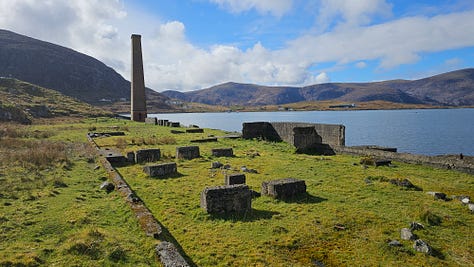
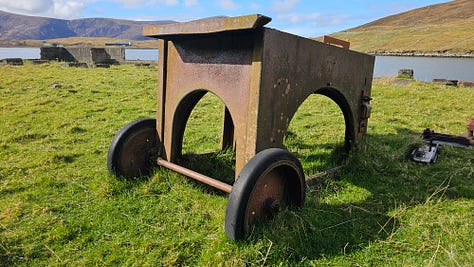
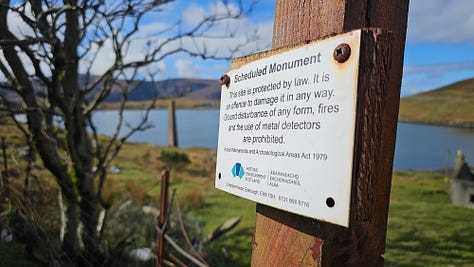
Now the ground is strewn with fragments of rope and the kind of jumbled plastic detritus that characterise coastlines worldwide, an expulsion of mess flicked up and deposited here with the spume by a sickened sea.
In hindsight, the story of Bunavoneader (Bunabhainneadar in the local Gaelic) is a sad one – but this was once a locus of ambition and hope. Today it’s mainly associated with the fate of one English industrialist, Lord Leverhulme, who purchased Harris in the 1920s and poured a vast investment into establishing a fishing empire here.
Next week will be the 100th anniversary of Leverhulme’s death, when I’ll write a little more about his vision for Harris and the lessons we might learn from its failure.
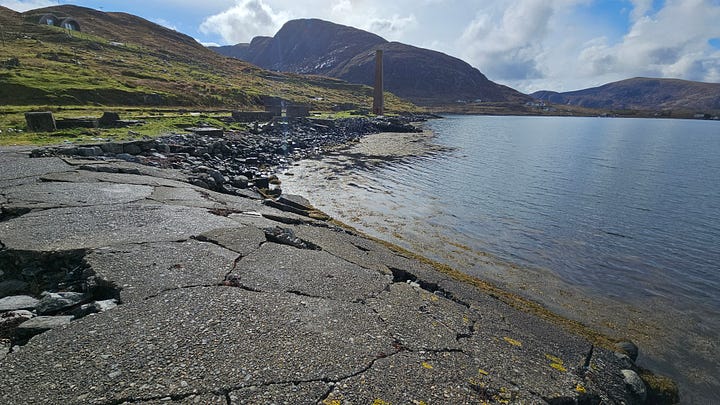
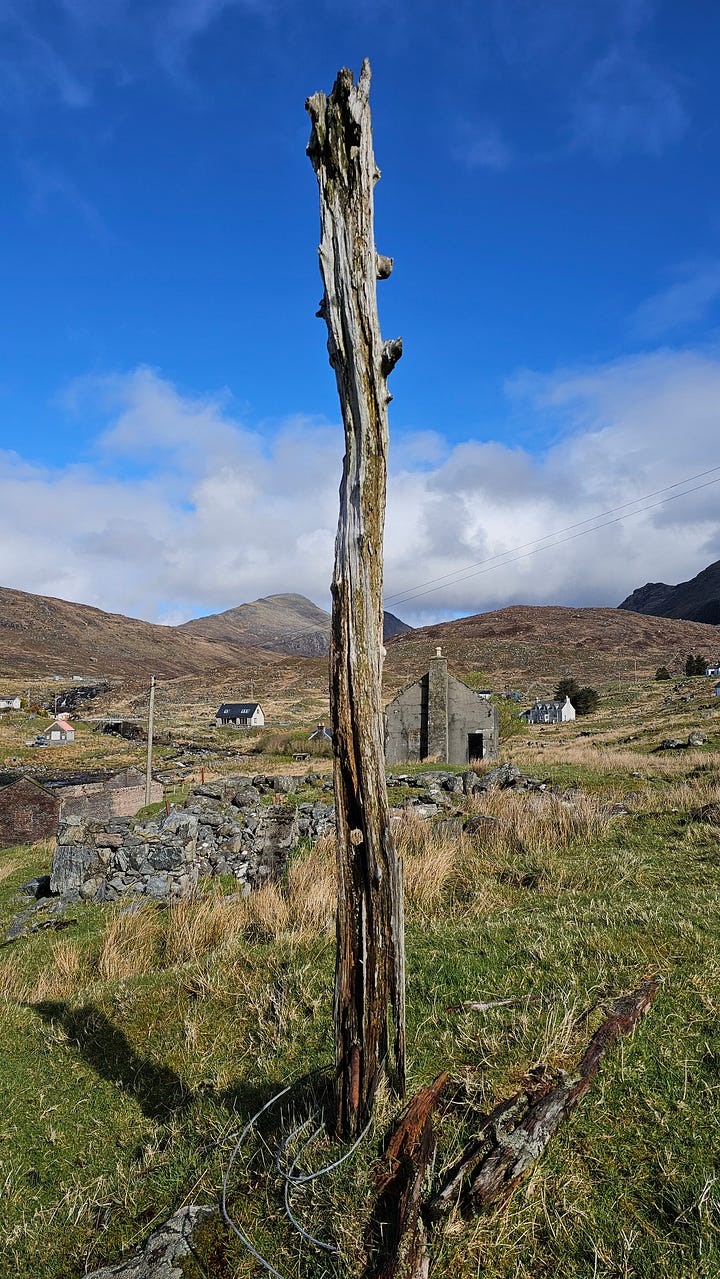
The whaling station at Bunavoneader was built by a Norwegian enterprise, a decade earlier than Leverhulme’s purchase, and when his estate sold his assets in the late 1920s the site fell into disuse. In the 1950s, another Norwegian whaling company attempted to revive the project, operating a German ship called Empire Unitas V that had been captured by the Royal Navy during WW2. But by this time, Atlantic whale populations were badly depleted, and after just two seasons the venture collapsed. (The ship was scrapped in 1955.)
Bunavoneader’s whaling station has been abandoned ever since.
The derelict chimney
Alfie and I spent last night in the Land Rover. I leave him snoozing in a layby and slink off to explore the ruins, and within seconds I’ve slipped on some wet grass and fallen flat onto a rock – prompting one of those hasty ‘nothing to see here’ moments when you quickly spring back up and continue, while a fresh bruise quietly throbs into being. (“Shit that hurt.”) For a brief moment, it had felt as though I too was part of the squelch, the decay, the abandonment, sinking into the earth.
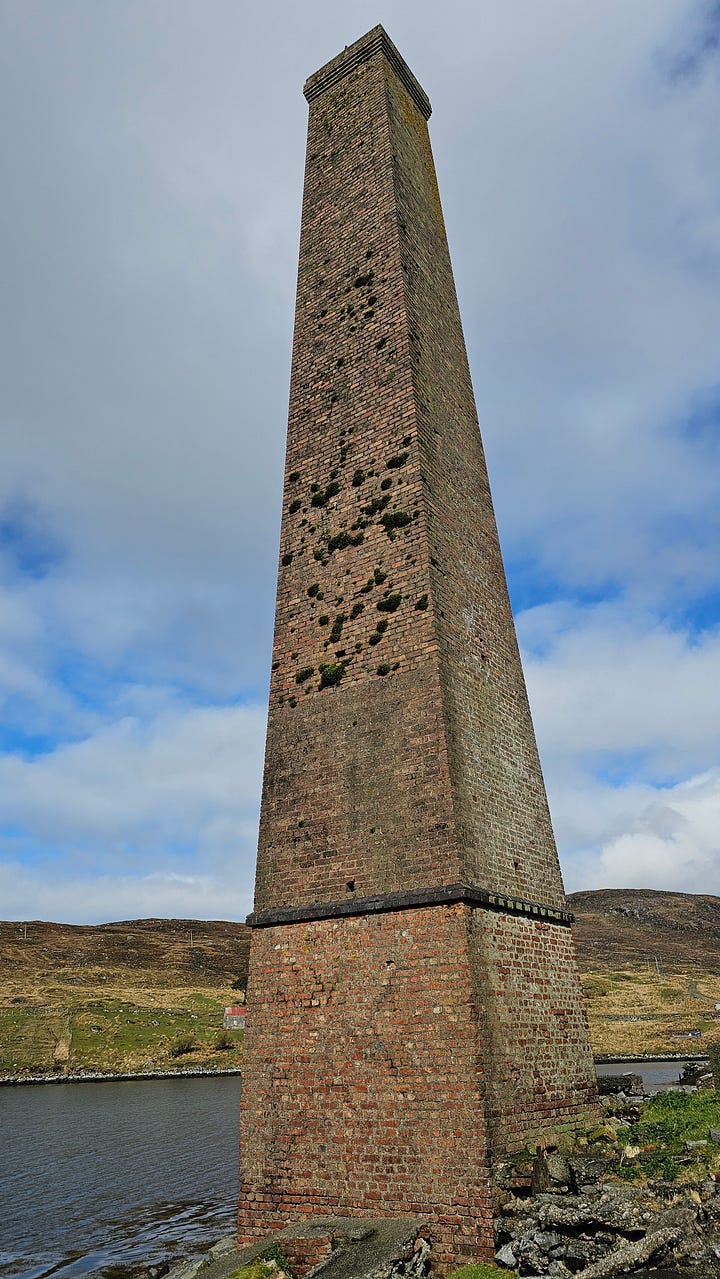

From that gruesome hardstanding, I wander over to the old chimney that has come to define this part of the island. By now my low buzz of excitement is tinged with disgust. It’s one of three chimneys that apparently used to emit quite a stench over the village. I’m reminded of a school trip to Auschwitz on a freezing February day nearly 20 years ago. There’s not much left there either, and although Auschwitz lost its chimneys shortly after the war, they somehow linger in my imagination. Industrial chimneys can be strangely evocative, symbolic of much that is cold and depleted and northern – especially when intended for the conversion of flesh into atmosphere.
Get there if you can and see the land you once
were proud to own
Though the roads have almost vanished and the
expresses never run;
Smokeless chimneys, damaged bridges, rotting
wharves and choked canals,
Tramlines buckled, smashed trucks lying on
their side across the rails […]
From ‘Poem XXII’ by WH Auden (1932)
Bunavoneader’s surviving chimney is in better condition than I expected, with green moss tufting out from its sunward face. Around the top rim, and ten feet up, simple rows of bricks give a basic nod to aesthetic form, but it’s a brutal old thing (brutalist, perhaps – the Cambridge University Library comes to mind), emitting an oozing stench of guano.
A few old wooden piles stick vertically out from the shoreline, revealing that this area had been manually extended into the sea. Old photos show large wooden buildings on this spot, transported here on steam ships from Iceland over a century ago. The sheer effort involved must have been staggering.
The remnants of an old trailer, on closer inspection, turn out to be not a trailer but a vintage car, so severely corroded by the Atlantic air that almost nothing remains. No bodywork, no interior. Just a skeleton chassis, split completely in two, with a bumper and some running gear. Even the steering column is broken in half. I’ve seen older shipwrecks in better shape. The track that it must have driven on to reach here, probably 70 years ago, is long gone.
No plans are in place to maintain the chimney at Bunavoneader, and it’s unlikely that funding will ever be found. Once enough granules of mortar have been scoured from between its bricks, ten years from now or two hundred, on a winter’s night in a hurricane gale, it will collapse into the sea.
A path to nowhere
It’s Alfie’s turn, so we attempt a walk up the glen above the village, but the footpath marked on the Ordnance Survey map turns out to be non-existent. Little dotted lines don’t appear on maps for no reason, so I’m curious about what this putative route used to be for, heading off in the direction of nothing but wildness. Theoretically it leads for about a mile to the western foot of the Clisham, the tallest mountain in the Hebrides. Press on and you’d reach Stulabhal and Loch Langabhat.
Like so many soil-buried clues, it seems to suggest layers of Hebridean history that have been swallowed up and washed away.


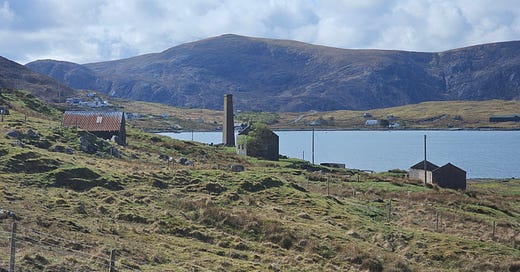



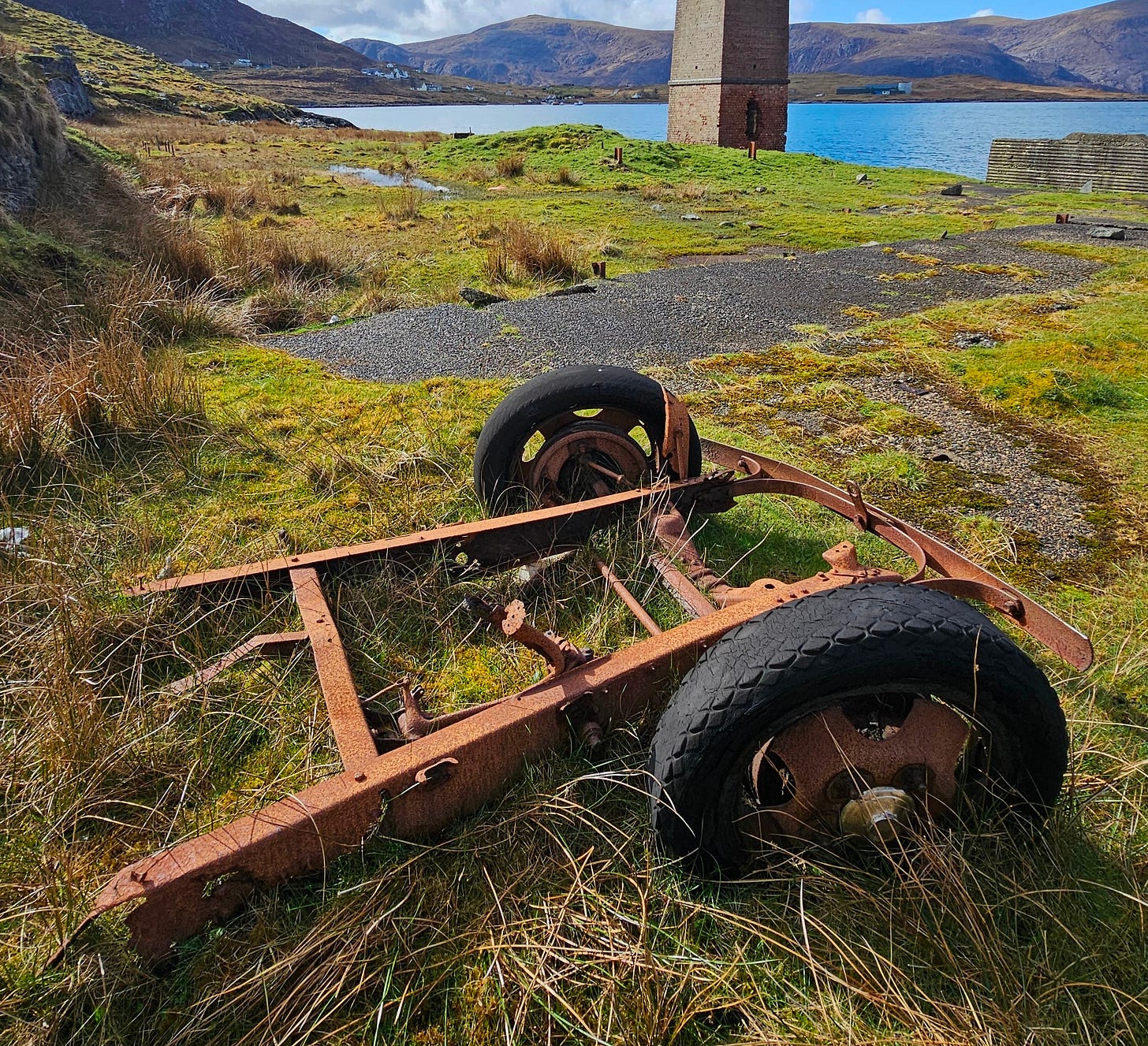
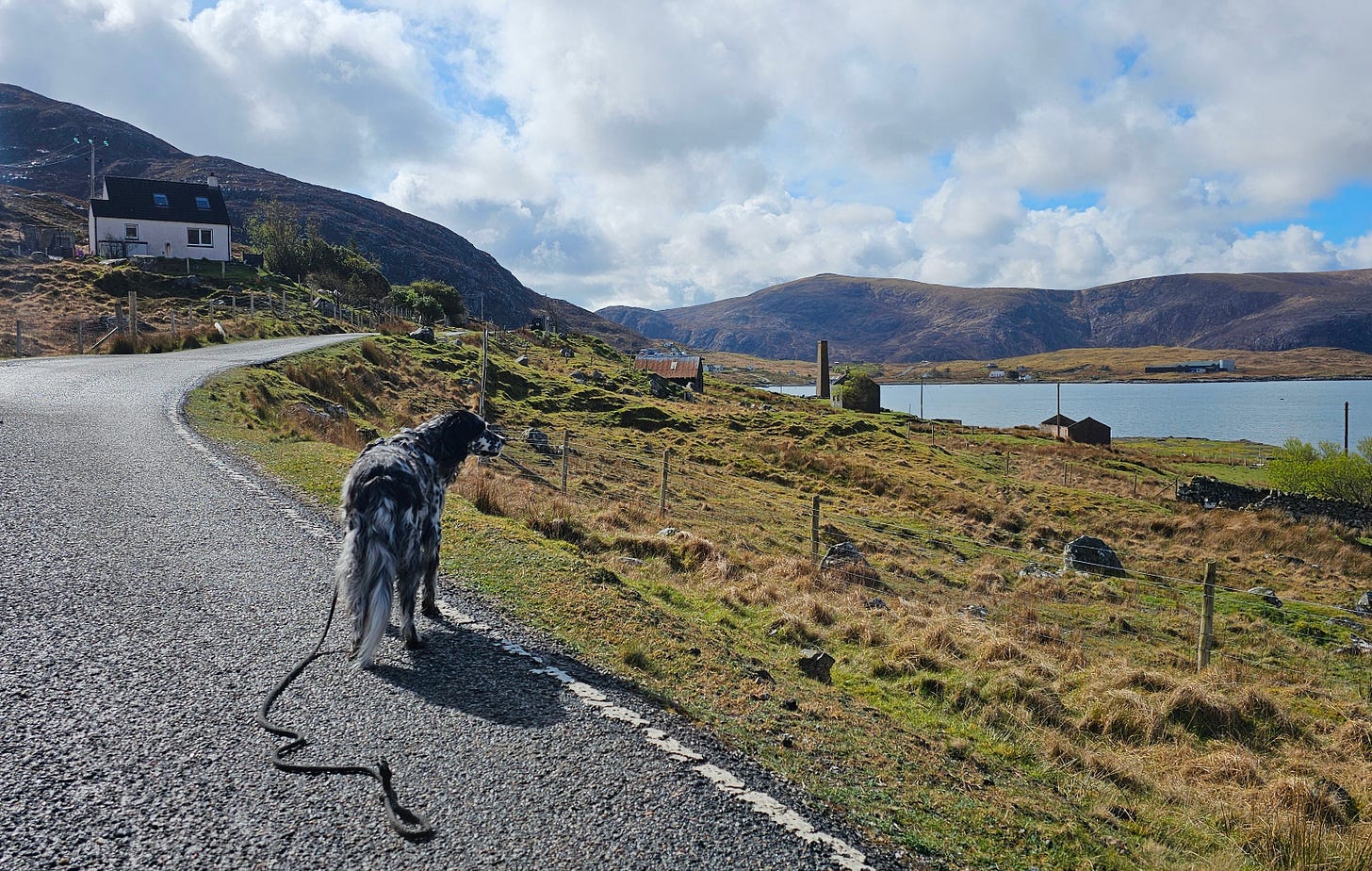
I like this one, Theo. It chimes with something; nostalgia / fascination with (relatively) recent history and the way things were for our ancestors, but also revulsion for the harm irrevocably done by people to the world. What will people in 100 yrs say about us?